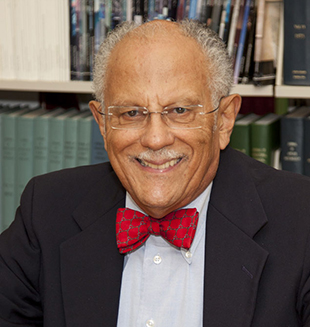

Warren M. Washington (1936 )
“We’re going to have to face up to something that’s going to affect our children and grandchildren.
I think what really wins out over time is that the science will speak for itself.”
–Warren M. Washington
National Medal of Science (NMS) recipient in 2009 “for his development and use of global climate models to understand climate and explain the role of human activities and natural processes in the Earth’s climate system and for his work to support a diverse science and engineering workforce.”
Warren Washington was born to an African American family in Portland, Ore., during a time when Oregon's black population constituted less than 1 percent of the state’s entire population. Washington, his family and their friends were targets of racial discrimination, which encouraged him to get involved in the civil rights movement at a young age. In high school, he served as the vice president of the Junior NAACP, an experience that he said “helped give me confidence that I could contribute to making a change.”
Both of Washington’s parents had attended college; his father worked for the railroad and his mother stayed home to care for the children. Washington had an early fascination with discovering how things worked. He developed an interest in astronomy from his father, who purchased a telescope when Washington was a child and set it up on the sidewalk in front of their home. Washington frequently visited his local library to borrow books about famous scientists and enjoyed working on engineering projects; to help them wake up for their paper routes, he and his brother rigged a push button near their mother’s bed that would ring an alarm in their room when she pressed it. Later, Washington’s teachers at Jefferson High School furthered his dual interests in science and social justice. Although his school counselor advised him not to go to college, he ignored this guidance and applied. He was accepted at Oregon State College (now Oregon State University), an achievement so significant to his family that Washington’s grandfather left his deathbed to go to the bank so he could transfer funds for his grandson’s college expenses.
After receiving his bachelor’s degree in physics, Washington remained at Oregon State to pursue a master's degree in meteorology. As a graduate student, he operated weather radar on the top of Mary’s Peak, the highest mountain peak in the Oregon Coast Range. Washington described the experience as “an interesting adventure in self reliance.” In the winter, he had to snowshoe to the top, and on one occasion, a large Air Force antenna blew over, narrowly missing his van. Upon completing his studies at Oregon State, Washington drove across the country with his wife, LaRae, and their newborn baby, Teri Lyn, to begin his Ph.D. program at the Pennsylvania State University. When he earned his degree in 1964, Washington became only the second African American to receive a Ph.D. in meteorology. The first, Charles E. Anderson, had been a weather forecaster for the Tuskegee Airmen, and was a valuable mentor to Washington.
While finishing his dissertation, Washington accepted a position at the National Center for Atmospheric Research (NCAR), a research and development organization in Boulder, Colo., funded primarily by the National Science Foundation. At NCAR, Washington quickly gained recognition for his work using computational models to represent the Earth’s atmosphere and climate. Together with senior scientist Akira Kasahara, Washington laid out a strategy for developing a new atmospheric computer model, which they pursued with the encouragement of their supervisor, Phil Thompson. Washington was later selected as the principal investigator for a project that utilized climate models to examine impacts such as global warming.
Washington’s influence has extended well beyond the laboratory. His 1986 book with Claire Parkinson, “An Introduction to Three-Dimensional Climate Modeling,” is considered a standard reference. He was the chair of the National Science Board from 2002-2006, and he has served as a science advisor to every U.S. President since Jimmy Carter. Washington has mentored dozens of students including undergraduates in the SOARS (Significant Opportunities in Atmospheric Research and Science) program at the University Corporation for Atmospheric Research (UCAR). In 2007, Washington shared in the Nobel Peace Prize as a member of the Intergovernmental Panel on Climate Change.
Encouraged by his wife, Mary C. Washington, Washington authored an autobiography, “Odyssey in Climate Modeling, Global Warming and Advising Five Presidents.” The book, edited by his wife, was published in 2006 and a third edition was published in 2012.
Image descriptions and credits
Any opinions, findings, conclusions or recommendations presented in this material are only those of the presenter grantee/researcher, author, or
agency employee; and do not necessarily reflect the views of the National Science Foundation.


